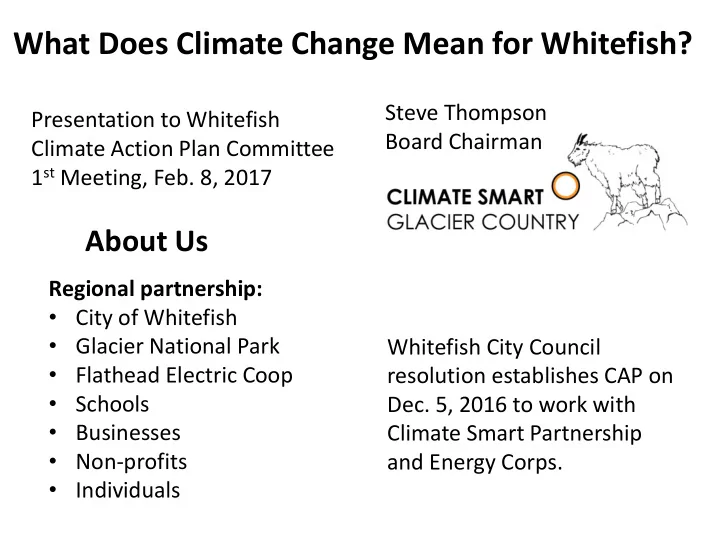

What Does Climate Change Mean for Whitefish? Steve Thompson Presentation to Whitefish Board Chairman Climate Action Plan Committee 1 st Meeting, Feb. 8, 2017 About Us Regional partnership: • City of Whitefish • Glacier National Park Whitefish City Council • Flathead Electric Coop resolution establishes CAP on • Schools Dec. 5, 2016 to work with • Businesses Climate Smart Partnership • Non-profits and Energy Corps. • Individuals
Our Climate Smart Approach Working Groups: • Built Environment • Transportation • Food and Soil • Green Business • Education & Outreach • Natural Resources
Climate Trends & Projections Montana Climate Assessment Due for public release, Spring 2017 National Climate Assessment http://montanaioe.org/mca 2014 NCA prepared by over 300 scientists, 13 federal agencies, many universities Presentation courtesy of Climate.Place http://nca2014.globalchange.gov/
U.S. Temperature Change Since 1900 Since 1900, average temps in Glacier region increased 2.4°F
Observed U.S. Precipitation Change Trends for NW Montana are mixed
Projected U.S. Temperature Change Whitefish average temperatures could increase 7 degrees F this century
Future Precipitation Projections Northwest Summary More intense downpours, primarily in winter More precip in winter/spring Hotter, drier summers Precipitation Change by Season by 2070 – 2100
Projections Depend upon Emission Scenario
Projections: More Extreme Downpours Frequency of extreme precip could increase 2- 3 times by 2100 2014 National Climate Assessment
More intense winter storms forecast for Northwest Heaviest winter storms in PNW will dump one-third more rain/snow per hour and arrive 4.6 times more frequently by 2100 Prein, A.F. et al, Nature Climate Change, 2016 Prein interview with KUOW Increase due to more frequent, intense atmospheric rivers
Atmospheric Rivers Satellite image of huge AR in Jan. 2016 Tropical fire hose aka “Pineapple Express” Projected increases in Northwest: • Precipitation due to extreme ARs increases by 15% – 39% by 2090s • Frequency above historical 99th percentile increases as much as 290% - shifting normal Mass and Salathe, et al, 2015
Expanding Flood Hazard Areas by 2100 FEMA 2013 report
Change in # of Consecutive Dry Days by 2100 15% increase by 2070-2100 relative to 1970-2000 National Climate Assessment
Megadrought Risk Nearly 50% chance of a drought 30 years or longer in duration by the end of this century if climate change is not mitigated.
Longer seasons of extreme fire danger Projected increase 2041-2070 compared to 1971 – 2000 NOAA, University of Idaho and US Forest Service report, August 2015
More Burned Areas in Northwest’s Future By the 2080s, the annual area burned in the Northwest would quadruple relative to the 1916 to 2007 period.
Wildfire Smoke Piles up in Montana Projections by 2050: • Smoky days to double in much of Montana • Particulate levels will increase by 31% Liu et al, 2016
Summary of Projected Impacts for NW MT • More intense downpours, primarily in winter • More precipitation in winter/spring • More rain, less snowpack, earlier snow melt • Hotter, drier summers • By the 2080s, the annual area burned in the Northwest expected to quadruple • Number of smoky days expected to double by 2050 • Annual average temperatures projected to increase 7 degrees F by 2071-2099 relative to 1970-1999 Projections based upon Representative Concentration Pathway (RCP) 8.5 - “Business as Usual” Emissions Scenario
Weighing Likelihood and Consequence
Green Resilience to Manage Risk Reduce emissions while preparing for change
Recommend
More recommend